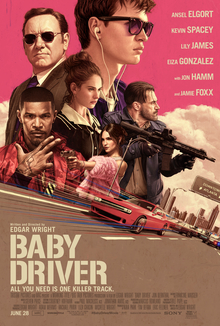| Baby Driver | |
|---|---|
 |
by Peter J. O’Connell
Baby Driver. Released:
June 2017. Runtime: 113 mins. MPAA Rating: R for violence and language
throughout.
With Baby Driver
writer/director Edgar Wright delivers an instant cult classic. The movie has
all the right attributes: cast a mix of seasoned thesps and young
up-and-comers; Tarantinoesque ultraviolence and snarky dialogue; obsessed
Lynchian characters; car chases and crashes a la the Fast and Furious franchise, except even more spectacular and rather
more realistic; a deep structure whose ancestry is rooted in film noir of the
1940s and ‘50s. And, notably, the film has a brilliantly unique use of music,
simultaneously diegetic and non-diegetic—a character (Baby) continually listens
to diverse music from the 1960s to the present, music that constitutes the
soundtrack of the movie and in various ways reflects or comments upon the
action. Sometimes everything happening on the screen, in effect, moves in
rhythm with the music that both Baby—and the audience—hears. (The music
includes the eponymous Simon and Garfunkel tune “Baby Driver.”)
Baby-faced Baby (Ansel Elgort) is a young man in Atlanta
working as a getaway driver for Doc (Kevin Spacey), a criminal mastermind who
specializes in meticulously planned heists. Baby is working for Doc only until
he can pay off a debt. Because Baby seldom speaks but listens to music on iPods
all the time, one of Doc’s crew asks: “Is he slow?” Doc explains: “He had an
accident when he was a kid. Still has a hum in the drum. Plays music to drown
it out. And that’s what makes him the best.”
There’s more to it than tinnitus, though. Baby started
listening to music as a young child in order to drown out his father’s abuse of
his mother, a singer. Following his mother’s death in an auto accident—caused
by abuse and with Baby in the car--the youngster began to function as if he had
PTSD or, perhaps, the combination of social awkwardness with great facility in
a specific field—in his case driving—seen in autistic savants. Baby does,
however, have a warm relationship with his elderly foster father (C.J. Jones),
a deaf mute whom he takes care of tenderly and who gives him good advice. Baby
also encounters a super-sweet waitress, Debora (Lily James), in a diner, with
whom he falls in love and she with him.
But Baby has difficult relationships with Buddy (Jon Hamm)
and Bats (Jamie Fox), two key members of Doc’s crew. Their violent propensities
create a tense atmosphere even when the gang is not carrying out its heists and
deals.
Baby and Debora hope to hit the road to the West, but
there’s that “one more job” for Doc. Moviegoers know how that kind of job
usually turns out. Baby Driver
handles the job with tricky twists and turns, in and out of cars—though,
perhaps, a few too many climaxes. In any case, it’s a cool thrill to ride along--even
in a theatre seat--with Elgort as Baby and the rest of a topnotch cast on a
summer’s day or evening.
“Footnote” to the
film: Another fairly recent movie featuring a possibly autistic getaway
driver is Drive (2011), starring Ryan
Gosling and Carey Mulligan.
Am I the only reader who had to look up diegetic?
ReplyDeletehttps://paulolohan.wordpress.com/2013/05/21/the-difference-between-diegetic-and-non-diegetic-sounds/